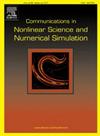复杂网络上无偏随机漫步产生的时间序列多重分形无趋势波动和基于秩的分析
IF 3.8
2区 数学
Q1 MATHEMATICS, APPLIED
Communications in Nonlinear Science and Numerical Simulation
Pub Date : 2025-04-10
DOI:10.1016/j.cnsns.2025.108831
引用次数: 0
摘要
本文在Erdös-Rényi (ER)随机网络、Watts-Strogatz (WS)小世界网络和Barabási-Albert (BA)无标度网络三种典型模型网络上,利用无偏随机行走同时生成了顶点度(VD)序列和顶点接近中心性(VCC)序列,并重点研究了这些序列的分布和相关性。首先,发现VD时间序列的分布继承了原始网络度分布的信息,从而有利于将BA网络与ER和WS网络区分开来。其次,对于相似度分布的ER和WS网络,将多重分形趋势波动分析(MF-DFA)应用于其VCC与VD比值序列,揭示出明显不同的多重分形相关性。因此,MF-DFA结果可以区分ER和WS网络。第三,我们采用基于秩的分析方法进一步研究了三种模型网络的VD和VCC系列及其相应的重组系列。三种网络的重组序列得到的标准差序列σ秩近似于严格高斯白噪声序列的常数;而它们的VD和VCC序列的σ阶级数与重组序列的σ阶级数有不同的偏离,因此可以捕捉到这些网络之间的内在区别。因此,提出的无偏随机漫步产生的时间序列分析可以有效地捕捉原始网络的固有性质,并进一步得到由分数布朗运动和现实世界生物网络构建的可见性网络的分析的支持。本文章由计算机程序翻译,如有差异,请以英文原文为准。
Multifractal detrended fluctuation and rank-based analyses of time series generated by unbiased random walks on complex networks
We simultaneously generate the vertex degree (VD) series and the vertex closeness centrality (VCC) series using unbiased random walks on three typical model networks, namely Erdös–Rényi (ER) random networks, Watts–Strogatz (WS) small-world networks, and Barabási–Albert (BA) scale-free networks, and then focus on distribution and correlation of these resultant series. First, distributions of the VD time series are found to inherit information about degree distributions of original networks so that benefit distinguishing the BA networks from the ER and WS networks. Second, for the ER and WS networks with the similar degree distributions, the multifractal detrended fluctuation analysis (MF-DFA) is applied to series of the ratio of their VCC to VD series, and reveals obviously different multifractal correlations. Therefore, the MF-DFA results can discriminate the ER from WS networks. Third, we employ the rank-based analysis to further investigate the VD and VCC series of three model networks and their corresponding reshuffling series. The resultant standard deviation series of reshuffling series for all three networks approximate a constant very close to that of the strict Gaussian white noise series; whereas the series of their VD and VCC series deviate from those of the reshuffling series in different patterns, and therefore can capture the intrinsic distinctions among these networks. Consequently, the proposed analyses of time series generated by unbiased random walks can effectively capture the inherent nature of original networks, which is further supported by analyses of a visibility network constructed from fractional Brownian motion and a real-world biological network.
求助全文
通过发布文献求助,成功后即可免费获取论文全文。
去求助
来源期刊

Communications in Nonlinear Science and Numerical Simulation
MATHEMATICS, APPLIED-MATHEMATICS, INTERDISCIPLINARY APPLICATIONS
CiteScore
6.80
自引率
7.70%
发文量
378
审稿时长
78 days
期刊介绍:
The journal publishes original research findings on experimental observation, mathematical modeling, theoretical analysis and numerical simulation, for more accurate description, better prediction or novel application, of nonlinear phenomena in science and engineering. It offers a venue for researchers to make rapid exchange of ideas and techniques in nonlinear science and complexity.
The submission of manuscripts with cross-disciplinary approaches in nonlinear science and complexity is particularly encouraged.
Topics of interest:
Nonlinear differential or delay equations, Lie group analysis and asymptotic methods, Discontinuous systems, Fractals, Fractional calculus and dynamics, Nonlinear effects in quantum mechanics, Nonlinear stochastic processes, Experimental nonlinear science, Time-series and signal analysis, Computational methods and simulations in nonlinear science and engineering, Control of dynamical systems, Synchronization, Lyapunov analysis, High-dimensional chaos and turbulence, Chaos in Hamiltonian systems, Integrable systems and solitons, Collective behavior in many-body systems, Biological physics and networks, Nonlinear mechanical systems, Complex systems and complexity.
No length limitation for contributions is set, but only concisely written manuscripts are published. Brief papers are published on the basis of Rapid Communications. Discussions of previously published papers are welcome.
 求助内容:
求助内容: 应助结果提醒方式:
应助结果提醒方式:


